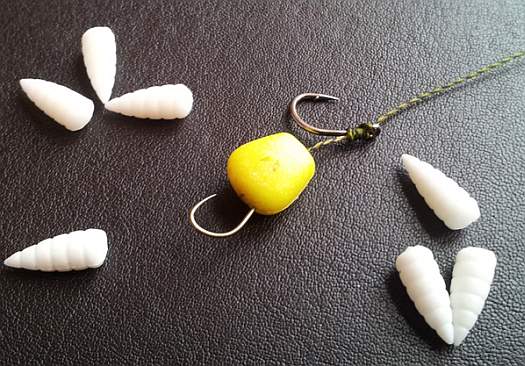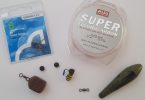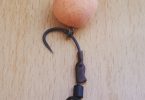Most of the rigs I use for carp fishing will catch fish at any time of the year, but the whole point of successful fishing for me is in being able to match the conditions you are faced with on the bank at certain times of the year with the perfect presentation; and the double hook rig is one that I’ll often turn to in the colder months… a little bit of movement and a splash of colour… what more could you want!?
The rig itself is nothing new; it’s been around for years in various guises and has been pushed by many anglers more capable than myself, yet seldom few use it out on the bank. I think the perception is that it must be tricky to tie, but in truth it’s just the opposite – the real beauty of this rig is that it’s deadly simple; it’s very easy to tie, and it’s very, very effective!
What’s more, it’s not just good for specimen carp; over the years I’ve used scaled down versions of this rig to catch specimen tench and bream and a friend of mine uses a slight variation for barbel on the rivers.
The idea of the rig is twofold; it offers a way to fish live maggots without the need for clips and rings, and does so in a way that makes it impossible for the maggots to escape. Secondly the use of the floating imitation corn adds a critically balanced dimension to the rig, so that when a fish comes over and sucks up the bait, the rig wafts up with consummate ease. The fact that there is also a splash of colour is just the icing on the carpy cake!
What you’ll need…
To make the rig you will need a length of braided hooklink material, a small barbless match hook (size between 12-16), and a normal carp hook; when using the rig I’ll use hooks from size eight to 12. I don’t use swivels in my rigs preferring a quick-link system, but if you use a swivel to attach your hooklinks to your rigs you’ll also need one of these.
How to tie…
- Take your chosen braided hooklink material and tie one end to the eye of the small match hook.
- Pierce the fake corn from the bottom edge using a baiting needle and carefully push it through so that the needle exits the top of the corn to one side.
- Attach the hooklink to the baiting needle and pull the hooklink back through the piece of corn.
- Hold the corn and gently pull the hooklink down so that the eye of the match hook embeds itself into the top of the corn. Keep going until the hook-point buries itself also, so that just the loop of the hook can be seen protruding from the top of the corn in a centrally mounted position.
- Attach the hooklink to your carp hook using a normal knotless knot approach, incorporating a swivel at the other end if required.

How to use…
To fish the rig you just pull the match hook out of the corn until the point is exposed, slide on a few maggots, and then pull the hooklink back down to bury the point of the hook back into the top of the corn, which in turn prevents the maggots from escaping. Alternatively, if there are a lot of nuisance species, you can use artificial maggots as I’ve shown in the images, though if I’m honest, even in this situation I’d rather use real maggots and change them more often, as I think it’s the movement of the maggots twinned with the splash of colour from the corn that really does the damage.
How to approach…
This is one of my top day-session rigs, and by that I mean that it’s one that I need to keep on top of during the session. It’s no good chucking it out for a long winter night and leaving it – you need to be checking it every hour or so – changing the maggots, recasting and topping up with some more loose fed maggots.
This little and often approach works really well during the winter. In such conditions I don’t like to over feed them (unless I’ve been pre-baiting) and so with this method I would just put out a few catapults of maggots and corn to the chosen area, and then keep topping up with maggots on a regular basis.
In the winter months I like to keep it simple; the less there is down there in terms of offerings and variation of offerings, the greater the probability they will pick up my hookbait when their appetite is not at its best, and for me much of the draw of this rig in the winter months is its ability to play on the inquisitive nature of the carp. In summer, however, I may look to bulk up the feed bed with hemp, wheat, maize particle mix or whatever. In this instance I’m actually looking to get them feeding with abandon first and then just hoover up the hooklink without really knowing it, as opposed to winter where I want them to see the hookbait first and single it out. As such, I go easy on the corn too, it’s the maggots that I’ll keep topping up with during the session.
Variations on the theme…
You can scale the rig up or down. To scale up you could use a pop-up boilie instead of corn, though again, an imitation boilie would be best as you’d only get a session out of a real one before it crumbled. To scale down you could use a small piece of foam or a piece of mini corn. After seeing me use this rig on still waters my friend who does a lot of river fishing used a variation whereby he used a bright yellow 15mm artificial boilie, with loads of chopped maggots on the loop. He’s caught just about everything on from double figure barbel, to big perch, pike and chub! He loves it as he never quite knows what he’s going to catch next!
As mentioned earlier, I’ve used it extensively in the past when targeting Estate lake tench and bream. When fished over a scattering of fresh hemp, corn and maggots it’s deadly on those warm summer mornings at dawn!
A good tip at any time of year is to flavour your maggots… I always add a good amount of curry powder to mine, and find this makes them twice as effective. By contrast, I’ll often use a piece of corn that’s been soaked in a fruity glug for months, offering a real sweet and savoury combination.
With any rig location is key, but when fishing this method I don’t like to fish too deep, and ideally want to fish a depth where they are going to see it. The clearer the water is, the deeper you can go, but on coloured waters I do like to fish the shallower areas. In winter, I love to use this approach in the shallower areas many anglers tend to avoid – on crisp sunny days you’ll often find the fish having a mooch around in the shallow water – especially if it gets the sun first and keeps it – and in such instances, presenting this little beauty is a great way of getting amongst them!
Julian Grattidge
December 2012
























